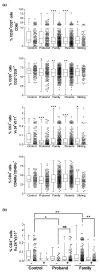Reduced proportions of natural killer T cells are present in the relatives of lupus patients and are associated with autoimmunity
- PMID: 18783591
- PMCID: PMC2592790
- DOI: 10.1186/ar2505
Reduced proportions of natural killer T cells are present in the relatives of lupus patients and are associated with autoimmunity
Abstract
Introduction: Systemic lupus erythematosus is a genetically complex disease. Currently, the precise allelic polymorphisms associated with this condition remain largely unidentified. In part this reflects the fact that multiple genes, each having a relatively minor effect, act in concert to produce disease. Given this complexity, analysis of subclinical phenotypes may aid in the identification of susceptibility alleles. Here, we used flow cytometry to investigate whether some of the immune abnormalities that are seen in the peripheral blood lymphocyte population of lupus patients are seen in their first-degree relatives.
Methods: Peripheral blood mononuclear cells were isolated from the subjects, stained with fluorochrome-conjugated monoclonal antibodies to identify various cellular subsets, and analyzed by flow cytometry.
Results: We found reduced proportions of natural killer (NK)T cells among 367 first-degree relatives of lupus patients as compared with 102 control individuals. There were also slightly increased proportions of memory B and T cells, suggesting increased chronic low-grade activation of the immune system in first-degree relatives. However, only the deficiency of NKT cells was associated with a positive anti-nuclear antibody test and clinical autoimmune disease in family members. There was a significant association between mean parental, sibling, and proband values for the proportion of NKT cells, suggesting that this is a heritable trait.
Conclusions: The findings suggest that analysis of cellular phenotypes may enhance the ability to detect subclinical lupus and that genetically determined altered immunoregulation by NKT cells predisposes first-degree relatives of lupus patients to the development of autoimmunity.
Figures


Similar articles
-
Differential expression of natural killer activating and inhibitory receptors in patients with newly diagnosed systemic lupus erythematosus.Int J Rheum Dis. 2016 Jun;19(6):613-21. doi: 10.1111/1756-185X.12289. Epub 2014 Feb 13. Int J Rheum Dis. 2016. PMID: 24617980
-
Changes of frequency and expression level of CD161 in CD8+ T cells and natural killer T cells in peripheral blood of patients with systemic lupus erythematosus.Microbiol Immunol. 2020 Jul;64(7):532-539. doi: 10.1111/1348-0421.12798. Epub 2020 May 26. Microbiol Immunol. 2020. PMID: 32343447
-
Natural killer T cells in families of patients with systemic lupus erythematosus: their possible role in regulation of IGG production.Arthritis Rheum. 2007 Jan;56(1):303-10. doi: 10.1002/art.22326. Arthritis Rheum. 2007. PMID: 17195234
-
Natural killer T cells and autoimmune disease.Curr Mol Med. 2009 Feb;9(1):4-14. doi: 10.2174/156652409787314534. Curr Mol Med. 2009. PMID: 19199937 Review.
-
Role of invariant natural killer T (iNKT) cells in systemic lupus erythematosus.Curr Med Chem. 2008;15(18):1778-87. doi: 10.2174/092986708785132988. Curr Med Chem. 2008. PMID: 18691038 Review.
Cited by
-
Activation status of mucosal-associated invariant T cells reflects disease activity and pathology of systemic lupus erythematosus.Arthritis Res Ther. 2017 Mar 14;19(1):58. doi: 10.1186/s13075-017-1257-5. Arthritis Res Ther. 2017. PMID: 28288675 Free PMC article.
-
Lipid-antigen presentation by CD1d(+) B cells is essential for the maintenance of invariant natural killer T cells.Immunity. 2012 Mar 23;36(3):477-90. doi: 10.1016/j.immuni.2012.02.008. Epub 2012 Mar 8. Immunity. 2012. PMID: 22406267 Free PMC article.
-
Disparate effects of depletion of CD1d-reactive T cells during early versus late stages of disease in a genetically susceptible model of lupus.Lupus. 2012 Apr;21(5):485-90. doi: 10.1177/0961203311428459. Epub 2011 Nov 7. Lupus. 2012. PMID: 22065098 Free PMC article.
-
Invariant NKT cells inhibit autoreactive B cells in a contact- and CD1d-dependent manner.J Immunol. 2011 Feb 1;186(3):1512-20. doi: 10.4049/jimmunol.1002373. Epub 2011 Jan 5. J Immunol. 2011. PMID: 21209282 Free PMC article.
-
Occupational and environmental exposures and risk of systemic lupus erythematosus: silica, sunlight, solvents.Rheumatology (Oxford). 2010 Nov;49(11):2172-80. doi: 10.1093/rheumatology/keq214. Epub 2010 Jul 31. Rheumatology (Oxford). 2010. PMID: 20675707 Free PMC article.
References
-
- Vyse TJ, Kotzin BL. Genetic susceptibility to systemic lupus erythematosus. Annu Rev Immunol. 1998;16:261–292. - PubMed
-
- Wakeland EK, Liu K, Graham RR, Behrens TW. Delineating the genetic basis of systemic lupus erythematosus. Immunity. 2001;15:397–408. - PubMed
-
- Sestak AL, Nath SK, Harley JB. Genetics of systemic lupus erythematosus: how far have we come? Rheum Dis Clin North Am. 2005;31:223–244. - PubMed
-
- Hom G, Graham RR, Modrek B, Taylor KE, Ortmann W, Garnier S, Lee AT, Chung SA, Ferreira RC, Pant PV, Ballinger DG, Kosoy R, Demirci FY, Kamboh MI, Kao AH, Tian C, Gunnarsson I, Bengtsson AA, Rantapaa-Dahlqvist S, Petri M, Manzi S, Seldin MF, Ronnblom L, Syvanen AC, Criswell LA, Gregersen PK, Behrens TW. Association of systemic lupus erythematosus with C8orf13-BLK and ITGAM-ITGAX. N Engl J Med. 2008;358:900–909. - PubMed
Publication types
MeSH terms
Substances
LinkOut - more resources
Full Text Sources
Medical

